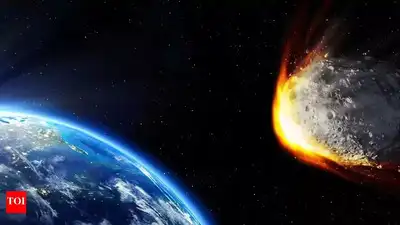Earth in danger? Giant 'city-killer' asteroids hiding near Venus could strike without warning; scientists warn | - The Times of India

Astronomers have found a cluster of giant asteroids co-orbiting the Sun with Venus—space rocks that might become a long-term hazard for Earth. These are not ordinary asteroids. Sometimes referred to as city killers because of their size, many are bigger than 140 meters; they are big enough to wipe out a whole urban centre upon impact. More concerning is that they can be hidden from our telescopes by the Sun's intense glare.These so-called co-orbital asteroids don't move in orbit around Venus but follow similar orbits around the Sun. Out of the 20 discovered to date, there are "Trojan" asteroids, which stay either in front of or behind Venus in its orbit, and a quasi-moon called Zoozve. They are said to have originated from the main
asteroid
belt between Mars and Jupiter and were later drawn into Venus's vicinity by gravitational forces.
The major issue with these asteroids is not only their size, but also how hard they are to observe. Their proximity to the Sun from our point on Earth means that it is almost impossible for telescopes on the ground to spot them. The light of the Sun drowns out their thin reflection, and astronomers are left with very brief glimpses of visibility; if any.".
Additionally, observational biases favor observing asteroids with high eccentricity (those that move widely around the Sun), as they sometimes come close to Earth where they are more easily seen. Conversely, low-eccentricity, co-orbital asteroids stand a better chance of being obscured in the Sun's glare as they go about their orbits. Currently, the discovered Venus co-orbitals do not threaten anything directly. However, that does not imply they are secure. The problem lies in their unstable orbits. Because these objects have no defined path, planetary gravitational jolts particularly from Earth may ultimately send them off course.Researchers at São Paulo State University ran simulations on what happened with these asteroids over 36,000 years. The simulations revealed that although most of the objects had relatively consistent paths, some had behavior that indicated they might wander towards Earth in the long term. Since Venus is only 40 million kilometers (25 million miles) from Earth, any change in course, even a small one, could eventually cause one of these giant space rocks to come close enough to raise alarms.
While the likelihood of a collision with Earth is still tiny, scientists advise that we shouldn't rule out the possibility altogether. Dr. Valerio Carruba, the author of the research, puts it this way, "I believe that we should not underestimate their potential danger, but I would not lose sleep over this issue."The largest problem is in the unknown; how many co-orbital asteroids remain undiscovered? Because many are likely to be blinded by sunlight and have orbits that conceal them, the 20 we are aware of might be only a small percentage of what actually exists.
As global efforts to enhance planetary defense increase, the finding of Venus co-orbitals emphasizes the necessity of widening our observation capacity particularly through space-based telescopes that are not confined by the Earth location or the Sun's effects. Since these objects don't have regular orbits and can change under the influence of gravity, they are some of the more unpredictable hazards in our solar system. The earlier we detect and follow them, the better equipped we'll be to react if one does stray into Earth's orbit.
Even though these asteroids are not an immediate threat, they are a blind spot in the study of
near-Earth objects
. Their size, proximity, and unpredictability qualify them for consideration not alarm, but attentiveness. The more our observation technologies and instruments become advanced, the more research such as this reminds us that what we cannot see can hurt us too and preparing for what we cannot see is an essential aspect of planetary defense.Also Read | Elon Musk’s feud with Trump puts $22B SpaceX contracts at risk; what it means for America’s space future











